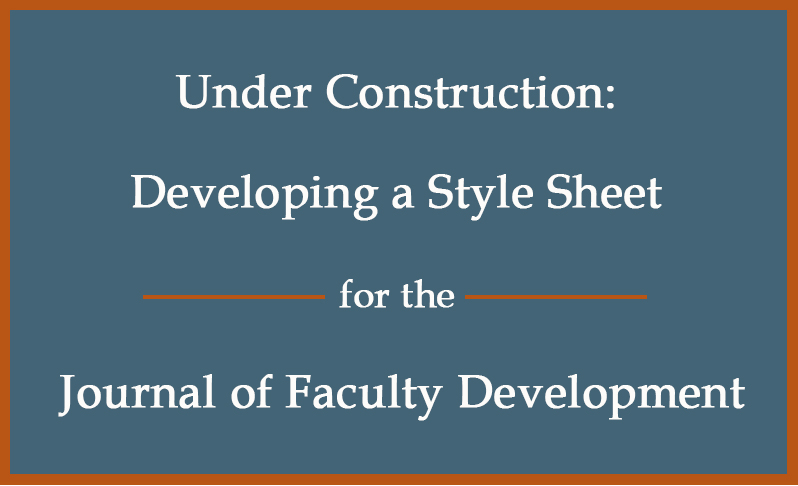The past few weeks we have been reading and rereading manuscripts for a special issue of the Journal of Faculty Development (JFD) on the future of faculty development. Rusty has taken over as the new editor of the Journal, and one of the things he would like to institute is a guide on writing, writing styles, and, specifically, some major grammatical suggestions. If you were to visit New Forums’ section of this website devoted to the JFD’s “Author Guidelines,” you would find instructions about following the APA Publication Manual (6th Edition), dealing with copyrighted materials, and the review process, but as of yet lower level concerns about grammar have not been addressed.
As a result, one of our projects has been developing these guidelines, and like our title indicates, these guidelines are “Under Construction.” What follows are a rationale and some guidelines. You might remember we began addressing this issue last year with our JFD article called “The Pancake Professor and the Decline of Scholarly Writing” [29.3 (2015): 69-70].
When you have finished this post and if you have any suggestions, please email them to us at [email protected].
Related Reading: Going to WAR: Using a Weekly Activities Report for Assessment
Rationale
Last April Manchester Guardian data editor Mona Chalabi (HT Daily Wire) opined that grammatical correctness is actually a type of white privilege, claiming that “Grammar snobs are patronizing, pretentious, and just plain wrong.” She continued, “All too often, it’s a way to silence people and that’s particularly offensive when it’s someone who might already be struggling to speak up” (we won’t point out her lack of a comma between two main clauses joined by a coordinating conjunction). In rebuttal, Newsbuster’s Melissa Mullins argued that grammatical correctness is more “a sign of an educated person.”
As writers of over 25 published books and 1200 articles as well as editors, we offer a third position. Grammar exists for one purpose, clarity, and the basic commandment of all grammar rules is “Thou shalt not confuse thy reader.” Note that by our employing pronouns not in current usage, we might have violated the key rule (especially for younger readers)—and confused you. Clarity is what allows both someone “struggling to speak up” and “educated persons” to communicate on the highest level. Grammar is not a privilege, but the appropriate tool for exchanging ideas. As Barry Wylant argues, “Indeed, even language forms a type of conceptual space where the rules of spelling and grammar allow one to make sense of individual letters and words” [“Design Thinking and the Experience of Innovation,” Massachusetts Institute of Technology Design Issues 24.2 (2008): 9].
To help our readers “make sense” of what our writers are trying to express, we ask those writers to follow the following guidelines.
Related Reading: How Design Thinking Helps Innovate Faculty Development, Part I
12 Grammar Guidelines:
1) Use consistent formatting of author bios, including degree. For example:
Charlie Sweet, Ph.D., is the Co-Director of the Teaching & Learning Center at Eastern Kentucky University. With Hal, he has collaborated on over 1100 published works, including 23 books, literary criticism, educational research, and novels (as Quinn MacHollister).
Hal Blythe, Ph.D., is the Co-Director of the Teaching & Learning Center. With Charlie, he has collaborated on over 1100 published works, including 22 books (eight in New Forums’ popular It Works For Me series), literary criticism, educational research, and a stint as ghostwriter of the lead novella for the Mike Shayne Mystery Magazine.
2) Try to avoid “There is . . .,” “There are . . . ,” and “It is . . . ” constructions.
3) “This” and “That” are always followed by a noun.
4) Authors should use the serial comma (i.e., one comma less than the total number of items in the list) for words, phrases, or lists in a series. For example: The journal publishes research, scholarship, and creative works. Semi-colons appear in a list only if the individual units contain commas.
5) A comma is used to separate two main clauses joined by one of the seven coordinating conjunctions: for, and, but, or, nor, so (that), yet. Place the comma before the conjunction.
6) Avoid “when” and “where after “is” in definitions.
7) Don’t use redundancies such as “the reason why” or “is because.”
8) Do not substitute “would be” for the present or past verb tense.
9) Use pronouns properly (e.g., “Terry was the kind of student that took tests poorly” should be “Terry was the kind of student who took tests poorly.”
10) Hyphenate two consecutive modifiers being used as a singular adjective (e.g., I developed a six-minute video on degree-completion students).
11) Use introductory commas (e.g., Therefore, I conclude that flipping goes well).
12) If APA does not provide a format for a reference, make one up as best you can following close examples. Be consistent if you have to make up similar references.
Any suggestions?
Author
 Charlie Sweet is currently Co-Director of the Teaching & Learning Center (2007+) at Eastern Kentucky University. Before going over to the dark side of administration, for 37 years he taught American Lit and Creative Writing in EKU’s Department of English & Theatre, where he also served as chair (2003-2006). Collabo-writing with Hal Blythe, he has published well over 1000 items, including 15 books; of his 11 books with New Forums. Meet Charlie.
Charlie Sweet is currently Co-Director of the Teaching & Learning Center (2007+) at Eastern Kentucky University. Before going over to the dark side of administration, for 37 years he taught American Lit and Creative Writing in EKU’s Department of English & Theatre, where he also served as chair (2003-2006). Collabo-writing with Hal Blythe, he has published well over 1000 items, including 15 books; of his 11 books with New Forums. Meet Charlie.



